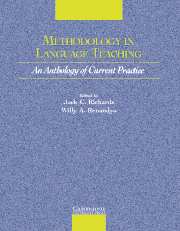Book contents
- Frontmatter
- Contents
- Acknowledgments
- Introduction
- Section I Approaches to Teaching
- Section 2 Lesson Planning and Classroom Management
- Section 3 Classroom Dynamics
- Section 4 Syllabus Design and Instructional Materials
- Section 5 Task and Project Work
- Section 6 Learning Strategies
- Section 7 Teaching Grammar
- Section 8 Teaching Pronunciation
- Section 9 Teaching Speaking
- Section 10 Teaching Listening
- Section 11 Teaching Vocabulary
- Section 12 Teaching Reading
- Section 13 Teaching Writing
- Section 14 Assessment
- Section 15 Technologies in the Classroom
- Section 16 Professional Development
- Credits
- Author Index
- Subject Index
Section 8 - Teaching Pronunciation
Published online by Cambridge University Press: 10 November 2010
- Frontmatter
- Contents
- Acknowledgments
- Introduction
- Section I Approaches to Teaching
- Section 2 Lesson Planning and Classroom Management
- Section 3 Classroom Dynamics
- Section 4 Syllabus Design and Instructional Materials
- Section 5 Task and Project Work
- Section 6 Learning Strategies
- Section 7 Teaching Grammar
- Section 8 Teaching Pronunciation
- Section 9 Teaching Speaking
- Section 10 Teaching Listening
- Section 11 Teaching Vocabulary
- Section 12 Teaching Reading
- Section 13 Teaching Writing
- Section 14 Assessment
- Section 15 Technologies in the Classroom
- Section 16 Professional Development
- Credits
- Author Index
- Subject Index
Summary
INTRODUCTION
The papers in this section deal with an aspect of learning which could either be the focus of a lesson or form a component of any lesson – pronunciation. Pronunciation (also known as phonology) includes the role of individual sounds and sound segments, that is, features at the segmental level, as well as suprasegmental features such as stress, rhythm, and intonation. The fact that few second language learners are able to speak a second language without showing evidence of the transfer of pronunciation features of their native language is evidence of the difficulty of acquiring a nativelike pronunciation, but also of the goals learners set for themselves. Many learners are quite comfortable to show evidence of their native language on their second language phonology, since it is sometimes viewed as a core part of their cultural identity.
Approaches to the teaching of pronunciation have changed significantly throughout the recent history of language teaching, moving beyond an emphasis on the accurate production of individual speech sounds to concentrating more on the broader, communicative aspects of connected speech. Many teachers, however, are unsure as to the status of pronunciation and whether or how it should receive systematic attention in a language course. Commonly asked questions are: Is pronunciation something that is worth teaching? How effective are any of the various approaches to teaching pronunciation found in course books and teaching materials? Is a direct or an indirect approach more effective?
- Type
- Chapter
- Information
- Methodology in Language TeachingAn Anthology of Current Practice, pp. 175 - 177Publisher: Cambridge University PressPrint publication year: 2002

